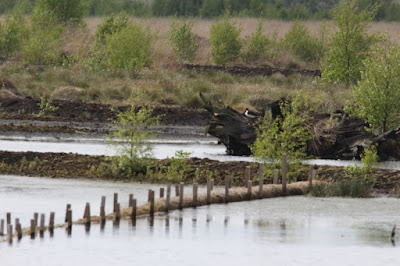 |
| Large red damselfly, Chat Moss |
It was one of those muggy sort of days that drains the energy and I didn't want to be messing about with trains so I got the 100 into Irlam and walked up Cutnook Lane into Chat Moss. There was birdsong aplenty in the hedgerows, mostly wrens, blackcaps and chiffchaffs, and over on the other side of the turf fields, beyond the hawking swallows, a yellowhammer struggled to make itself heard over the sounds of the motorway and a singing song thrush.
 |
| Cutnook Lane |
I carried on past Twelve Yards Road and had a go at peering through the birch scrub to see what was on the pools. I could hear mallards but struggled to find even the one I did manage to see. Walking down the path, as the trees got younger so willow warblers started to take over from the chiffchaffs.
 |
| Kestrel, Chat Moss |
I had a quick glance over the open peat moss beyond, finding nothing bar a couple of carrions crows, a lapwing and a passing kestrel so I turned onto the path that runs parallel to Twelve Yards Road. Whitethroats and willow warblers sang in the birch scrub, goldfinches twittered about and ducks called in the pools hidden by trees.
 |
| Looking towards Twelve Yards Road |
There was an embarrassment of large red damselflies, my first damsels of the year, and I had to double-check my identification because a large red damselfly is nobody's giant insect. (Small red damselflies are quite scarce so it's sensible to default to large when you see a thin red damselfly no matter how small you think it looks.)
A pair of buzzards soared around each other overhead, at one point passing something between them.
 |
| Buzzards, Chat Moss |
The large pool North of the path was, by its lights, heaving. Half a dozen pairs of mallards and a pair of tufted ducks cruised the margins while a couple of very noisy pairs of Canada geese sat on islands. There were around a dozen lapwings, very vocal and quite flighty. One of them swooped low over a patch of mud and chased off two wood sandpipers that were hidden by bushes. They flew over to the other end of the pool and disappeared behind rough sedges. I've no idea why the lapwing took against them. The lapwings over by Twelve Yards Road had good cause for being bad tempered as a pair of carrion crows were doing a very efficient job of egg stealing.
 |
| Chat Moss |
The clouds rolled by as I carried on down and turned onto Twelve Yards Road for the walk down to Little Woolden Moss. There were more whitethroats singing in the drains and lots of woodpigeons on the fields or loafing in the big trees. A couple of yellowhammers joined the mixed flock of linnets and goldfinches chunnering at me as I passed by. Orange tip butterflies had been a feature of the afternoon, the warming afternoon brought out dozens of them along this stretch of road.
 |
| Orange tip, Chat Moss |
I scanned the fields by Four Lanes End for wheatears or yellow wagtails and found neither. There weren't even any lapwings or carrion crows.
 |
| The entrance to Little Woolden Moss |
I negotiated the huge mound of gravel dumped in the entrance to Little Woolden Moss and had a walk round. Wrens, willow warblers and chiffchaffs sang in the trees by the entrance. More willow warblers sang in the scrub along the path and a few linnets twittered about. Oddly I didn't see any meadow pipits. A hobby soared briefly over the open pools then flew off towards the coverts near the motorway.
 |
| Hare's tail grass, Little Woolden Moss |
Little Woolden Moss was in a giving mood, so long as you put the work into looking round. Pairs of mallards and Canada geese were dotted round the pools and a pair of gadwall cruised by the site of the old hide. The only wagtails I could find were pied wagtails. They looked to be nesting and one male was performing threat displays against any lapwings or little ringed plovers that approached one particular mudbank. The lapwings were very active and the usual family of carrion crows weren't given an easy time whenever they flew by. It took me a while to find the oystercatchers.
 |
| Oystercatcher, Little Woolden Moss |
The newly-ploughed fields on Mosslands Farm had sitting lapwings. There didn't look to be any in the barley fields either side of the footpath. I'd given up on seeing any yellow wagtails today when one popped up and started calling from the tree at the corner of the path. A fine looking male but I couldn't see any companions. Every year I forget that yellow wagtails sound more like pipits than pied or grey wagtails. And I found a female wheatear on the turf field behind the poly tunnels.
 |
| By Moss Road |
The hedgerows along Moss Road were busy, including a few tree sparrows amongst the house sparrows. I'd just passed Red House Farm when I heard a sharp call overhead. I don't know what I was expecting but it wasn't a little tern. Why it was heading for Astley I have no idea.
The Glaze was running low and, surprisingly, had no birds on it nor any sand martins feeding over it. I walked down and got the bus to Warrington from Fowley Common Road and thence the train home. It had been a tiring walk but a productive one and I'd unexpectedly added four species to the year list.

No comments:
Post a Comment